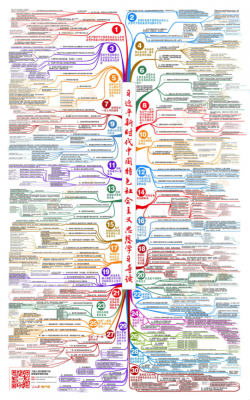Headlines and Hashtags
The Medicine Cabinet
The mobile news app of the Chinese Communist Party’s official People’s Daily newspaper recently released a colorful chart that mapped the complex system of President Xi Jinping’s central governing concept, “Xi Jinping Thought on Socialism With Chinese Characteristics for a New Era” (习近平新时代中国特色社会主义思想). The chart had 30 main branches shooting off from the primary trunk of this supreme buzzword, and each branch, dealing with various aspects of policy and ideology, proliferated into numerous sub-branches.

The idea, it seems, was to map out “Xi Jinping Thought” as a coherent and comprehensive system of ideas. But the result is certainly not simplicity, and it is tempting to imagine what Xi himself might have thought - assuming the unlikely scenario that he actually did see the chart sometime during his busy schedule running the country, and assuming his tired eyes could actually focus on its intricate patterning of concepts.
We can’t know Xi Jinping’s mind on the subject of this mind map. But we can consider another point. Xi Jinping has no doubt read the works of Mao Zedong. And if he has read the speech Mao Zedong gave in Yan’an on February 8, 1942, called “Opposing Stereotyped Party Writing” (反对党八股), then he should know that Mao Zedong would likely have a very clear stance on this recent mind map.
Mao would absolutely despise it.
In the Mao era, the language that prevailed on the Chinese mainland was not only “false, exaggerated and empty,” or jia da kong (假大空) - meaning that it was dominated by high-minded and formalized nonsense - but it was also nearly identical wherever one found it. Hundreds of newspaper articles, in other words, could essentially say the same tedious version of nothing.
The language of Mao Zedong, however, was markedly different. In the Mao era, it was as though hundreds of millions of people had their personal power of expression completely throttled by a single man who was free in his own language and writing to be as distinct and individualistic as he pleased. Consider that at one point Mao Zedong even managed to work into his poetry the undeniably colorful line: “No more flatulence!”
Mao Zedong detested the so-called “eight-legged” essay, or bagu wen (八股文), that had been demanded for imperial examinations during the Ming and Qing dynasties. He dismissed rigid and formalistic styles within the Chinese Communist Party as “Party eight-leggedness,” or dang bagu (党八股) – what is often translated as “stereotyped Party writing.”
In “Opposing Stereotyped Party Writing” (反对党八股), Mao Zedong listed out the eight sins of the eight-legged style. There were, for example, “pages of empty verbiage, devoid of substance” (空话连篇, 言之无物). There was “pretentiousness for the sake of intimidating others (装腔作势, 借以吓人). There was “aimlessness [in expression], done without consideration of one’s audience” (无的放矢, 不看对象). There was “language of a tasteless sort, like that of a beggar” (语言无味, 像个瘪三). And there was also what we might translate “the exhaustive use of the medicine cabinet” (甲乙丙丁,开中药铺).
Describing what he called the “fifth sin,” Mao Zedong wrote:
The fifth sin of stereotyped Party writing is the exhaustive use of the medicine cabinet. This is like going to see the [traditional Chinese] pharmacist, where the many compartments of the medicine cabinet list out the names of medicinal herbs - angelica sinensis, rehmannia glutinosa, rhubarb, mirabilite – anything you could possibly need, and you take a bit of everything. This method has been followed by our comrades. In writing essays, in making speeches, in writing books, in composing reports, first you have ONE, TWO, THREE, FOUR; then you have one, two, three, four; after that you have I, II, III, IV; next you bring up the earthly branches; then you move on to A, B, C, D; and from there to a, b, c, d; and finally on to Arabic numerals. There’s not end to it!
Our poor translation aside, the idea here is essentially that Party officials compile their speeches and writing by tossing in every established phrase they can, as though taking a bit of medicinal herb from every compartment of the medicine cabinet.
There’s no need for us to beat around the bush. The complicated mind map of Xi Jinping Thought released by the news app of the People’s Daily is Mao Zedong’s fifth sin for stereotyped Party writing brought into the age of the infographic. It is a medicine cabinet of Xi Jinping Thought.
This map is divided into 30 main items, each obsessively color-coded, and then within each of these there are one to three larger branches, and then one to three smaller ones, piled up and densely packed like veins. For all of the chart’s exhausting order, the dry and unrelatable concepts remain utterly incomprehensible.
This is precisely the sort of thing Mao Zedong loathed.
Not surprisingly, Mao’s “Opposing Stereotyped Party Writing” did come up as Chinese discussed the chart on social media. One user commented by updating a relevant passage from Mao’s 1942 essay to suit modern technology, inserted the portion in bold below:
“It is no big thing if someone engages in stereotyped Party writing for their own perusal. If they give it to a second person, that a 100 percent increase, and this causes a lot of trouble. And if they paste it to a wall, or make a mimeograph copy, or run it in the newspaper, or print it as a book, or post it on the internet through a mobile news app, well then this is a big problem, and it can influence many people.”




















